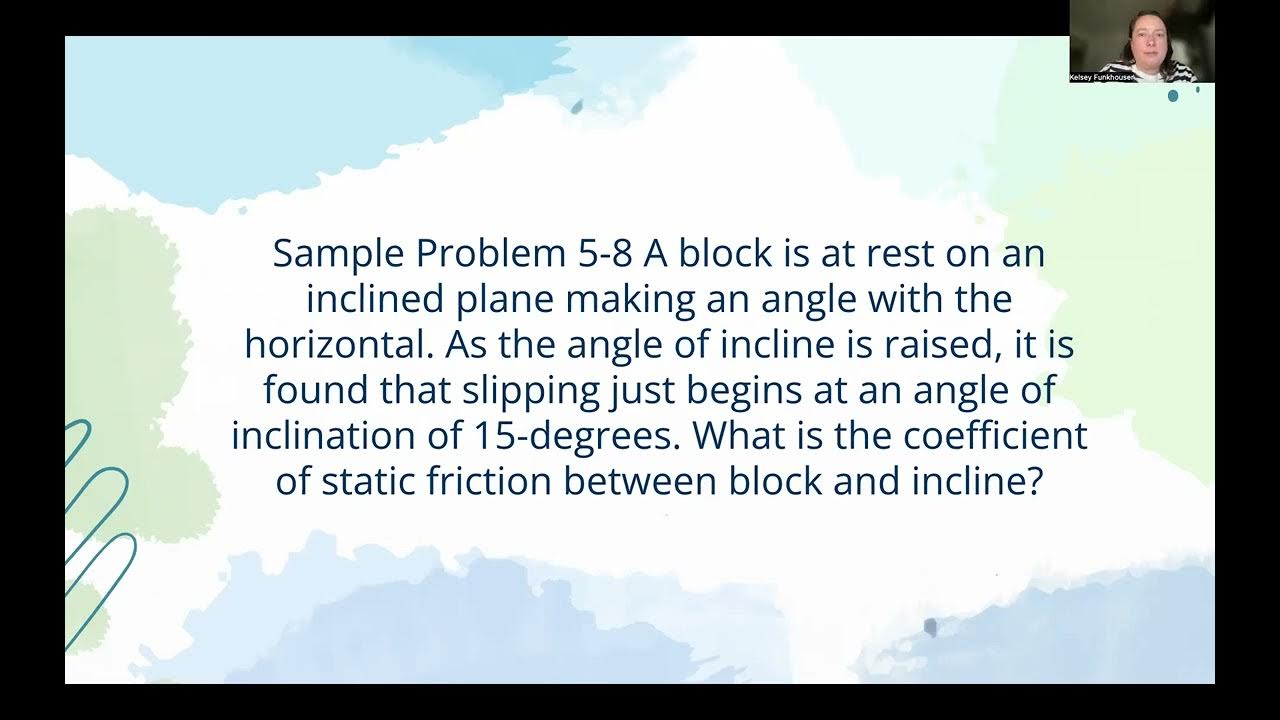Friction 5 (Static and Kinetic)
Summary
TLDRThis video demonstrates the principles of static and kinetic friction using a block on a flat surface. It highlights how more force is required to overcome static friction and initiate motion (around 4.5 N) than to maintain motion once the block is moving (about 2.5–3 N). The video also explains the concepts of the coefficient of static and kinetic friction, and how these forces interact with applied force. The block accelerates when the applied force exceeds kinetic friction, illustrating the difference between balanced and unbalanced forces in motion.
Takeaways
- 😀 It takes more force to get an object moving than it does to keep it moving.
- 😀 Static friction is the frictional force that resists the initial movement of an object at rest.
- 😀 Kinetic friction occurs once an object is in motion and is typically lower than static friction.
- 😀 The spring balance measures the force required to overcome both static and kinetic friction.
- 😀 The force required to start moving a block is called the threshold force and corresponds to the static friction coefficient.
- 😀 Once an object is in motion, less force is required to maintain its motion due to kinetic friction.
- 😀 The formula for both static and kinetic friction is F = μ × FN, where μ is the coefficient of friction and FN is the normal force.
- 😀 The coefficient of static friction is different from the coefficient of kinetic friction.
- 😀 A push with less force than the maximum static friction (e.g., 1 or 3 Newtons) results in no movement or a force equal to the applied push.
- 😀 When the applied force exceeds the static friction threshold (e.g., 5 Newtons), the object starts to move and the kinetic friction takes over.
- 😀 If an unbalanced force is applied while the object is moving, it will cause the object to accelerate due to the difference between the applied force and kinetic friction.
Q & A
Why does it take more force to get something moving than to keep it moving?
-It takes more force to overcome static friction, which resists the initiation of motion. Once the object starts moving, the force required to overcome kinetic friction is lower because kinetic friction is typically smaller than static friction.
What is the difference between static friction and kinetic friction?
-Static friction is the force that resists the initiation of motion when an object is at rest, while kinetic friction is the force that resists the motion of an object already in motion. Static friction is usually greater than kinetic friction.
What is the coefficient of static friction?
-The coefficient of static friction is a constant that represents the ratio between the maximum static friction force and the normal force. It determines how much force is needed to start moving an object.
What happens when the applied force reaches the threshold needed to overcome static friction?
-When the applied force reaches the threshold required to overcome static friction, the object begins to move. Afterward, kinetic friction takes over, and the force needed to maintain constant velocity decreases.
Why does the force required to move an object decrease after it starts moving?
-Once the object is in motion, kinetic friction takes over, which is weaker than static friction. This results in a decrease in the force needed to maintain constant velocity.
What is the formula for calculating frictional force?
-The formula for calculating frictional force is F = μ × FN, where F is the frictional force, μ is the coefficient of friction (either static or kinetic), and FN is the normal force.
What is the coefficient of kinetic friction?
-The coefficient of kinetic friction is a constant that represents the ratio between the kinetic friction force and the normal force. It determines how much force is needed to keep an object moving at a constant velocity.
How do static and kinetic friction values differ in the example with a block on a table?
-In the example, the static friction force is 5 Newtons, meaning it takes 5 Newtons to get the block moving. The kinetic friction force is 3 Newtons, which is the force needed to keep the block moving at a constant velocity once it has started.
What happens if you apply a force of 1 Newton to a block with static friction of 5 Newtons?
-If you apply 1 Newton of force, the friction will match the applied force (1 Newton) because it is below the threshold required to overcome static friction. The block will not move.
What happens when the applied force exceeds the static friction threshold?
-When the applied force exceeds the threshold of static friction, the object starts moving. Afterward, the friction changes to kinetic friction, which is lower than static friction.
Outlines

此内容仅限付费用户访问。 请升级后访问。
立即升级Mindmap

此内容仅限付费用户访问。 请升级后访问。
立即升级Keywords

此内容仅限付费用户访问。 请升级后访问。
立即升级Highlights

此内容仅限付费用户访问。 请升级后访问。
立即升级Transcripts

此内容仅限付费用户访问。 请升级后访问。
立即升级浏览更多相关视频

PHYS 121 - Week 4 Lecture 2 - Friction & Circular Motion

Contoh Soal FISIKA SMA - Gaya Gesek Kinetis dan Statis

Fuerza de fricción o rozamiento

Grade 11 Physics - Static and Kinetic Friction Example

Si el bloque está a punto de resbalar. ¿Cuál es el valor del coeficiente de rozamiento

Work due to Friction equals Change in Mechanical Energy Problem by Billy
5.0 / 5 (0 votes)
